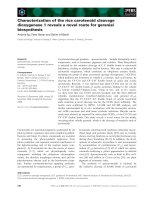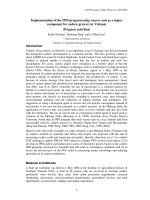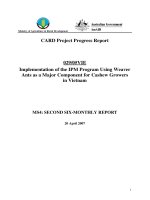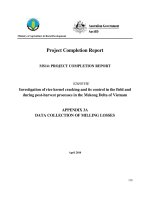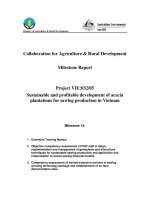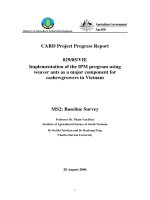Project Progress Report: " Implementation of the IPM program using weaver ants as a major component for cashew growers in Vietnam - Milestone 10 " pptx
Bạn đang xem bản rút gọn của tài liệu. Xem và tải ngay bản đầy đủ của tài liệu tại đây (57.06 KB, 10 trang )
1
Ministry of Agriculture & Rural Development
Milestone 10
Competence Evaluation
Renkang Peng, Keith Christian and La Pham Lan
December 2008
2
1. Institute Information
Project Name
Implementation of the IPM program using weaver
ants as a major component for cashew growers in
Vietnam
Vietnamese Institution
Institute of Agricultural Science of South Vietnam
Vietnamese Project Team Leader
Mr La Pham Lan
Australian Organisation
Charles Darwin University
Australian Personnel
Prof. Keith Christian and Dr Renkang Peng
Date commenced
February 2006
Completion date (original)
January 2009
Completion date (revised)
Reporting period July 2008
Contact Officer(s)
In Australia: Team Leader
Name:
Keith Christian
Telephone:
61 8 89466706
Position:
Professor
Fax:
61 8 89466847
Organisation
Charles Darwin
University
Email:
In Australia: Administrative contact
Name:
Jenny Carter
Telephone:
61 08 89466708
Position:
Research Manager
Fax:
61 8 89467199
Organisation
Charles Darwin University
Email:
In Vietnam
Name:
La Pham Lan
Telephone:
84 0913829560
Position:
Head of Plant Protection
Department
Fax:
84 8 8297650
Organisation
Institute of Agricultural
Science of South Vietnam
Email:
3
Summary
This competence evaluation has been done based on (1) the quality control of TOT
training, (2) an objective assessment of the competence of 56 TOTs as trainers of
another 56 TOTs, (3) an assessment of the TOT trainers to conduct FFS in different
environments, and (4) an assessment of the farmers’ adoption of project interventions.
For enhancing TOT training quality, 14 experts in various aspects of integrated
cashew improvement technology in Australia and Vietnam were invited to be TOT
master trainers. A total of 112 plant protectionists with extensive experience in rice
and/or vegetable IPM programs or in FFS training were chosen for this cashew IPM
training. The results from all the course reports indicated that the TOT trainees were
keen to learn the cashew IPM methods, and they were very interested in the field
practical. All the master trainers did their best to pass their knowledge to the TOT
trainees. A final examination at the end of each TOT training was held, and all the
TOT trainees successfully passed their examinations.
In an assessment of the competence of 56 TOTs as trainers of another 56 TOTs, the
results from class surveys showed that all the TOT trainers expressed confidence in
applying cashew IPM methods in farmers’ orchards and in opening FFSs. Compared
with the general results of the first year 56 TOTs, the second year 56 TOTs were
slightly more confident.
To assess the ability of TOT trainers to conduct FFS in different environments, four
sources of information were used: farmers’ comments about the TOT trainers, the
TOT trainers’ reports, farmers’ meetings held by the project staff, and participation in
the FFS training. Farmers commented that the training methods set up by the TOT
trainers were suitable to their local cashew growing conditions, and that the training
methods, focusing on field surveys, observations, practice and discussion, were
appropriate and meaningful. They especially appreciated the benefits from weaver
ants and from having less impact on the environment. From the TOT trainers’ reports,
it is clear that the TOT trainers are very capable with respect to the FFS training using
the cashew IPM methods. From farmers’ meetings held by the project staff, all the
farmers were pleased with the TOT trainers’ abilities, their training methods and
skills, and their understanding in the cashew IPM program. A lot of farmers said that
they never had such good training since they planted cashews. Through participating
in the FFS training given by the second year TOT trainers, although the TOT trainers
made some minor mistakes, we were satisfied with their training methods and their
knowledge of the cashew IPM program.
For assessing farmers’ adoption of the cashew IPM program, three farmer meetings
were held in October 2008. A total of 75 farmers attended the meetings, and among
them, 19 were women. The results are summarised below:
(1) All farmers said that they used to kill weaver ants using insecticides due to
their aggressive behaviour, but from now on, they will protect the ants in their
orchards,
(2) The majority of them are planning to use weaver ants in part of their orchards
in this coming season to have a further test and to further familiarise
themselves with the ant management methods they learnt from FFSs,
4
(3) All the farmers were pleased with the improvement of the farm environment
by not using toxic pesticides,
(4) Most farmers only knew 1 or 2 cashew insect pests or diseases before the FFS
training, but after the training, they know most of the major pests in their
orchards, and
(5) The majority of farmers did not know natural enemies before the FFS training,
but now they can recognise several important natural enemy species, such as
weaver ants, ladybirds, preying mantis and wasps.
5
Introduction
Based on the logframe of our research proposal, this competence evaluation includes:
(1) an objective assessment of the competency of 56 TOTs as trainers of
another 56 TOTs,
(2) an assessment of the TOT trainers to conduct FFS in different
environments, and
(3) an assessment of the farmers’ adoption of the project interventions by the
participating cashew farmers.
Before addressing these assessments, it is necessary to describe the approach the
project staff took to control the TOT training quality in order to make the TOT
trainers competent for FFS training using the cashew IPM program.
1. Quality control for the TOT training
1.1. Selection of TOT master trainers
When selecting master trainers, the following two criteria were used:
(1) he or she must have had expertise in relevant areas of tree crop production,
ideally in cashew production, and
(2) he or she must have had teaching experience, eg university teaching, TOT
teaching and/or adult training.
A total of 14 TOT master trainers were invited, and their expertise and experiences
are shown in Table 1. Most of them are well known for their expertise in Vietnam.
1.2. Selection of TOT trainees
To produce high quality cashew TOT trainers, we selected plant protectionists in
provincial sub-PPDs of cashew growing provinces who have had experience in using
crop IPM programs or with FFS training. A total of 112 plant protectionists (56 in the
first year and 56 in the second year) from 10 cashew growing provinces were chosen
for this cashew IPM training (Table 2). Of the 112 TOT trainees, 96 were previously
trained in the rice IPM program and/or vegetable IPM program, and they have run
FFSs, and the remaining 16 had FFS training experience.
1.3. Course report and TOT trainees’ comments
At the end of each TOT training period, each master trainer was asked to submit a
course report to ensure the quality of the course training and to improve the next TOT
training. Each report included
(1) the objectives of the course,
(2) the main course contents,
(3) the activity of the course practical, and
(4) comments about the course from the TOT trainees,
All the course reports have been summarised in our milestone reports 1 to 5. From
these reports, two points of interest emerge:
(1) the TOT trainees were keen to learn the cashew IPM methods, and they were
very interested in the field practicals, and
6
(2) all the master trainers did their best to pass their knowledge to the TOT
trainees.
1.4. Graduation examination of TOT trainees
Graduation examinations were conducted at the end of each TOT training. A total of
15 questions were set, which covered every aspects of cashew plant protection and
cultivation, especially the use of the weaver ant technology. The results showed that
all the TOT trainees (56 in the first year and 56 in the second year) successfully
passed their examinations. Each of them was awarded a graduation certificate in the
cashew IPM training. Now, we have 112 TOT cashew IPM trainers, and they are
distributed in ten cashew growing provinces (Table 2).
Table 1. Expertise and experience of TOT master trainers.
Experience in teaching
Name Organization* Expertise
Univer.
teaching
TOT
training
Adult
training
Dr RK Peng CDU Weaver ant
technology, Cashew
pest control and
production.
X X X
Mr LP Lan IAS Plant protection X X
Mr NT Binh IAS Cashew breeding
and cultivation
X X
Mr DV Tu IAS Cashew cultivation X X
Mr DD Hien IAS Fertilizer application X X
Mr HX
Quang
IAS Cashew diseases and
their control
X X
Dr DT Binh IAS Cashew cultivation X
Ms NT Thien
An
NLU Bio-ecology of
Cashew insect pests
X X
Mr HV Chien SRPPC Weaver ant use in
citrus
X X
Mr LQ
Cuong
SRPPC Petroleum spray oil
application
X X
Dr TV Hai CTU Insecticide use in the
IPM system
X X
Dr NT Thu
Cuc
CTU Weaver ant biology,
IPM principles
X X X
Ms LT Sau Binh Duong
Sub-PPD
Activation of class X
Ms HTH Lan CEPORER Communications X
* CDU = Charles Darwin University ; IAS = Institute of Agricultural Science of
South Vietnam ; NLU = Nong Lam University; SRPPC = Southern Regional Plant
Protection Centre
of the Plant Protection Department of Vietnam; CTU = Cantho
University; CEPORER = Centre de Parrainage des Orphelins et Enfants de la Rue.
7
Table 2. Number of cashew TOT trainers in each of the 10 cashew-growing provinces
in Vietnam.
Number of TOT trainers
Province
Year 1 Year 2 Total
Binh Phuoc 11 8 19
Dak Lak 66 12
Dak Nong 45 9
Binh Duong 10 9 19
Dong Nai 12 8 20
Binh Thuan 44 8
Ba Ria Vung Tau 88 16
Ninh Thuan 2 2
Tay Ninh 4 4
Tra Vinh 4 4
Total 56 56 112
2. Objective assessment of the competence of 56 TOTs as
trainers of another 56 TOTs
Following graduation examinations, we conducted class surveys to ask the TOT
trainees to express their confidence in using the cashew IPM program in farmers’
orchards and in opening FFSs. We set up 5 rank scales: 1 = very confident; 2 =
confident; 3 = good; 4 = less confident; 5 = not confident (Tables 3 and 4). In terms of
the confidence in applying cashew IPM methods, all the trainees chose from 1 ‘very
confident’ to 3 ‘good’ (Table 3). A similar characterisation holds true for their
confidence in opening FFSs in their local areas (Table 4). Comparing the general
responses of the first and second year TOT trainees, the second year TOT trainees
showed slightly better confidence in using cashew IPM methods and in opening FFS
respectively (Tables 3 and 4). This may be due to the fact that we improved our
training methods after accepting the comments and suggestions obtained from the first
year TOT trainees. In addition to this, the competence of TOTs as trainers can also be
seen in the following assessment.
Table 3. Confidence in using cashew IPM methods in farmers’ orchards.
TOT trainees 1 (%) 2 (%) 3 (%) 4 (%) 5 (%)
First year 56 0.0 54.0 46.0 0.0 0.0
Second year 56
8.2 46.9 44.9 0.0 0.0
1 = very confident; 2 = confident; 3 = good; 4 = less confident; 5 = not confident
Table 4. Confidence in opening FFS after this TOT training,
TOT trainees 1 (%) 2 (%) 3 (%) 4 (%) 5 (%)
First year 56 8.0 54.0 38.0 0.0 0.0
Second year 56
18.4 42.9 38.8 0.0 0.0
1 = very confident; 2 = confident; 3 = good; 4 = less confident; 5 = not confident
3. Assessment of 112 TOTs to conduct FFS in different environments
There are four sources of information we used to assess the competence of the TOT
trainers:
8
(1) Farmers’ comments about the TOT trainers,
(2) The TOT trainers’ reports,
(3) Farmers’ meetings held by the project staff, and
(4) Participation in the FFS training.
Because the FFSs conducted by the second year TOT trainers are still on-going, the
results of farmers’ comments, TOT training reports and the farmers’ meetings are
based on the first year FFS training.
3.1. Farmers’ comments about the TOT trainers
Based on 28 first year FFS training reports, farmers’ comments are summarised
below:
(1) The training programs set up by the TOT trainers are applicable to their local
conditions,
(2) The training methods, focusing on field surveys, observations, practice and
discussion, are appropriate and meaningful, and
(3) The demonstration orchards managed by FFS farmers under the supervision of
the TOT trainers have given them a lot of new knowledge, especially related
to the benefits from weaver ants and by having less impact on the environment
by not using toxic pesticides.
3.2. The TOT trainers’ reports
Based on the requirements of the project staff, each TOT trainer’s report must
contain:
(1) A training program based on local cashew growing conditions,
(2) The layout and the results of demonstration orchards,
(3) The improvement of the farmers’ knowledge,
(4) The willingness of farmers to use the cashew IPM methods,
(5) Farmers’ comments and suggestions, and
(6) The TOT trainers’ suggestions and comments.
A total of 28 FFS reports were received, and all the reports addressed the above 6
issues properly, showing that the TOT trainers had full knowledge of the cashew IPM
program, and were capable of running FFS training. Their suggestions and comments
were very useful for us to plan the second year FFS training.
3.3. Farmers’ meetings held by the project staff
In October 2008, the project staff held 3 farmers’ meetings. A total of 75 farmers
(including 19 women), who graduated from the first year FFS training in Ninh Thuan,
Binh Thuan and Binh Phuoc provinces, attended the meetings. All of them were
pleased with the TOT trainers’ abilities, their training methods and skills, and their
understanding of the cashew IPM program. A lot of farmers said that it was the best
training they had received about cashews. Although weaver ants are abundant, the
farmers never knew about their benefits until the TOT trainers demonstrated the
results from demonstration orchard.
3.4. Participation in the FFS training
9
A total of 112 TOT trainers (56 from the first year TOT training and 56 from the
second year TOT training) have jointly run a total of 81 FFSs in 10 cashew growing
provinces since September 2008. In order to assess the second year TOT trainers’
competences, the project staff participated in several FFSs organised by the second
year TOT trainers in Dong Nai and Binh Phuoc provinces in October 2008. Under the
supervision of the TOT trainers, we worked with farmers for the field sampling and
the identification of insect pests and diseases and their damage symptoms. We also
participated in their class discussion. Although some minor mistakes were made by
the TOT trainers, in general, we were satisfied with their training methods and their
knowledge of the cashew IPM program. We will continue to assess and supervise the
FFS training throughout this cashew season (flowering, fruiting and harvesting).
From the above assessments, we conclude that our TOT trainers are very competent in
using the cashew IPM program and in FFS training in different environments.
4. Assessment of farmers’ adoption of project intervention
Because our second year FFS training is still on-going, the assessment of farmers’
adoption of the cashew IPM program cannot be done until May 2009. However, we
have already had 698 farmers who have graduated from the first year FFS training. To
assess these, two methods were used:
(1) conducting farmers’ survey by asking them to fill in a standard questionnaire,
and
(2) holding farmers’ meetings to get their comments and suggestions.
A total of 220 questionnaires have been sent to the first year FFS farmers through
provincial sub-PPDs, and these questionnaires will be collected and analysed in
January 2009. The results will be reported in the project validation report.
With respect to the farmers’ meeting, we held 3 farmer meetings in Ninh Thuan, Binh
Thuan and Binh Phuoc provinces in October 2008. A total of 75 farmers (including 19
women) attended the meetings. Each of them expressed his or her opinions on the use
of the cashew IPM program. The results are summarised below:
• Almost all farmers said that the cashew IPM program was just the one they
need for their continuity of cashew production because it does not need many
inputs, but maintains high yield and nut quality. This is because, currently,
cashew growers can only earn small profits from cashews due to the high costs
of insecticides, fungicides, herbicides, fertilizers and unstable cashew nut
prices. This has resulted in a considerable shift from cashew to rubber trees
due to the high price of rubber.
• The IPM methods demonstrated in demonstration orchards are very practical
and easy for farmers to follow.
• Most farmers said that they used to kill weaver ants using insecticides due to
their aggressive behaviour, but from now on, they will protect the ants in their
orchards.
• The majority of them are planning to use weaver ants in part of their orchards
in this coming season to have a further test and to further familiarise
themselves with the ant management methods they learnt in the FFSs.
10
• Most FFS farmers have made suggestions to their local governments that they
would like to establish ‘High cashew yield clubs’ to pass this IPM knowledge
to other farmers in the region.
• All farmers were pleased with the improvement of the farm environment by
not using toxic pesticides.
• Most farmers only knew 1 or 2 insect pests or disease in their orchards before
the FFS training, but now they know most of the major pests after the training.
• The majority of farmers did not know natural enemies before the FFS training,
but now they can recognise several important natural enemy species, such as
weaver ants, ladybirds, preying mantis and wasps.
• With the positive influence of the current FFSs, there is high demand by many
local cashew farmers to participate in the cashew IPM training.
